Small business owners are basically human versions of Swiss army knives.
Tackling everything from pitching to prospects to managing employee morale… there’s probably little that you don’t personally get involved with.
With this kind of broad focus, it’s not hard to see why excelling in various business functions all at the same time can feel like a lot to keep up with.
For small business owners tasked with wearing multiple hats and don’t yet have the resources to hire specialists, a common approach might look like trying out many different techniques to find one that sticks.
For instance, for an owner trying to reach a new customer base, she might host a trade show one month, try out a social media campaign another, and rent out advertising space the next.
This way of trying out new techniques to find one that pays off might work some of the time, but in the end, if it’s not supported by data or research, it can still be an inefficient approach.
With the growing importance of remote or work from home options, best practices don’t just concern the customers you reach, but the employees that support you as well.
One of the ways to get as close as a guarantee to success as you can is to do what’s already been proven to work.
In this post, we’ll be covering:
- Why you should care about “best practices”
- 8 best practices every small business owners needs to know
- Ways to start applying best practices to your business today
Why should I pay attention to best practices for small businesses?
The term best practices isn’t just some jargon used to sell books. Well, at least, it shouldn’t be. It’s actually what you need to be paying attention to if you want to make the best use of the resources (time, money, people, and energy) you have.
Best practices are essentially a set of guidelines that help you most efficiently and sensibly approach a task. There are broad best practices all business owners should be aware of (like nailing your first impression with a customer), but each function (like sales, marketing, and HR) also has its own specific set of best practices, which we’ll get into in just a bit.
The reason business owners should be aware of best practices is because it allows them to make use of others’ trials and errors to their advantage—without having to make the same costly mistakes themselves.
Though some people might argue that repeating what’s been done hampers innovation, there’s value in learning from experience (and we encourage you to think critically about each best practice in this post to see if it’s right for your particular business).
And remember, using a best practice isn’t just about replicating the method to a tee. It’s also about breaking it apart, looking at all the components of what makes it successful, and adapting it so that it works for you.
8 best practices every small business owner needs to know
1. Be clear about what your brand stands for
When you think of the Disney brand, what comes to mind? Probably something along the lines of celebrating imagination and the spirit of play:

Think of your own business as having an equally strong brand personality that customers can remember you by. To do this, first determine what your core values are. This is what your business stands for, and what gives you a unique position to stand out among your competitors who offer similar products or services.
For example, if you run a vegetarian restaurant, you might stand for social responsibility and ethical farming. Everything you put out in your marketing and advertising should be a reflection of those values in order to solidify that message for your customers.
If you’re just starting to think about this for the first time, check out this model to get help brainstorming different ways you can come up with your values:
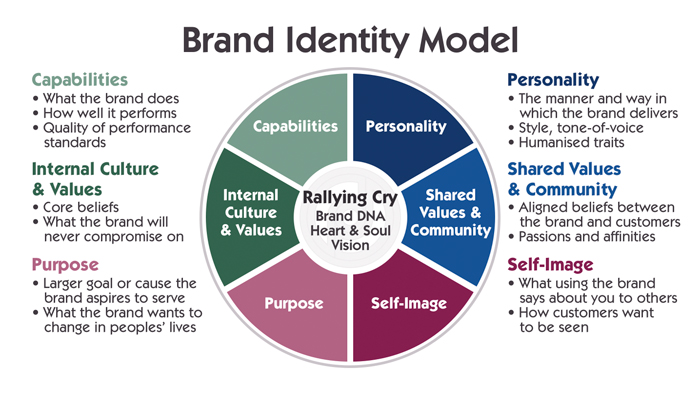
- Capability: What does the brand do better than any other? (e.g. offer the freshest vegetarian meals at the best value)
- Internal culture and values: What are some beliefs the brand will never compromise on? (e.g. never support unethical farming)
- Purpose: What’s the larger social goal the brand aspires to? (e.g. eat less meat by helping others realize vegetarian food can be delicious and affordable)
- Personality: What’s the style and tone-of-voice when your brand interacts with customers? (e.g. warm, humble, educated)
- Shared values and community: What are universal beliefs that your brand shares with customers? (e.g. animal rights are important for everyone)
- Self-image: How will customers be seen if they buy into your brand? (e.g. as conscientious, mindful consumers)
- Rally cry: Summarizes the vision (e.g. eat ethical for less)
Once you establish clear brand values, make sure you’re consistently embodying them as a company—from the employees you hire down to your customer interactions.
For instance, if one of your brand values is to support ethical farming, then maybe your…
- Social media profiles raise awareness about animal cruelty.
- Team lunches support restaurants that buy directly from local farms.
- Community of customers believe in humane treatment of farm animals.
2. Use data-driven marketing to gain clarity
If you’re using a website to market your business, starting a blog to promote your company, or putting content out through social media, make sure to set yourself up for success by measuring the engagement you’re getting on those channels.
Hootsuite, for example, is a popular social media manager tool that helps you track engagement of your social media posts so that you can see what type of content is performing well (has the most views or likes for instance)—and have a better idea of what kinds of images to use or what kinds of content to create more of in the future:

Depending on your business and what industry you’re in, the blend of online versus offline marketing is going to be different for you.
Pro-tip: The best practice here isn’t to prescribe a one-size-fits-all style of marketing, but to be aware of how you can use data to make better decisions about where to direct your marketing efforts.
3. Offer all-in-one ways to communicate
These days, everyone seems to have their own preferences when it comes to communication—it’s not just with employees, it’s customers too.
Turns out that texting isn’t just the obvious way of connecting with friends and family. 78% of people who text wish they could have a text conversation with a business.
Whether it’s through text, video, phone, or instant messaging, setting up boundless ways to connect enables your employees and customers to get what they need, when they need and how they need it at their choice. Plus, it empowers your remote workforce to collaborate in ways that eliminate some of the challenges of not being there in person.
If your business uses one communication tool for messaging, another for video conferences, and a third for texting, as you could imagine this makes for a pretty clumsy experience when you need to bounce back and forth between the three.
Instead, consider using an app like RingCentral that allows you to group all your communication tools into one place so that you can save time without needing to switch back and forth between apps.

When a customer calls through your number listed on Google or messages you from your site’s chat screen, you can start tending to these all from one location.
4. Use feedback to improve customer satisfaction
The good, the bad, the ugly… no matter what type of customer feedback you’re receiving, all of it is valuable (even if it bruises your ego a bit).
You’ve probably seen social proof in action before—you know, when you pass a huge line outside a restaurant and think “I have to try this”. Except, sometimes social proof exists online or in-person as well: through positive online reviews and word-of-mouth referrals.
But sometimes, feedback isn’t so positive. Your team might just be having a bad day, which leads to you getting a scorching review on Google. It’s easy to get discouraged, but negative feedback is a blessing in disguise (as long as they’re not happening constantly). Criticism, especially if it’s constructive, just gives you insight on how you can provide better customer service.
Before any of this happens though, you have to set up methods in place to collect that customer feedback. Here are a few ways to do it:
- Register your business online with services like Google
- Send out feedback surveys
- Set up community forums
When asking for feedback, keep the request or survey short, easy, and accessible. If your customers need an extra nudge, you could look at offering small incentives like discounts.
Once you receive feedback, make sure they’re being tracked and managed in one centralized location so that your team can actually take action on them.
Start your
remote-ready business in 10 steps

HR and finance
5. Switch to an automated payroll service
If your business is small and you’re managing only a couple employees, you might’ve (by default) started managing payroll manually or by using a spreadsheet.
As your business grows, it can be a challenge to make sure you’re paying employees on time and in compliance with the legislations of the country your employees reside in (this is a particular point of challenge if you’re managing remote employees in other countries that have very different tax and regulatory systems).
One way to do this is to set up a payroll system (under 20 employees? Check out this free solution from Rise) that can help you automatically pay employees, calculate deductions, generate tax reports, and even create financial forecast reports.
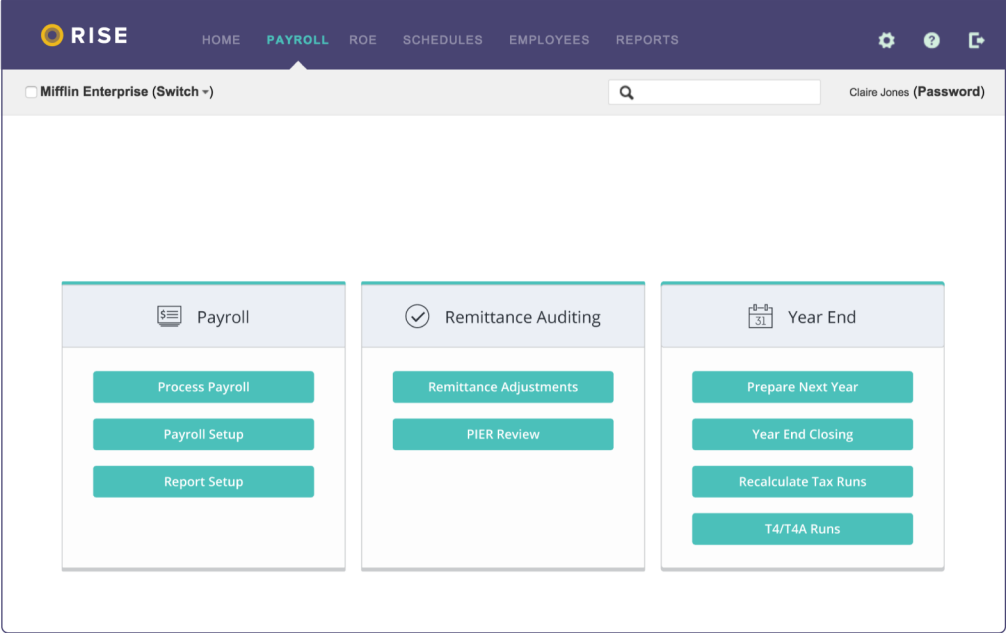
By using an electronic payroll service, you can minimize human error—and remove a few administrative tasks from your plate too, while making year-end reporting less of a burden since you’re not doing everything manually. Win-win.
6. Have clear hiring criteria in place
Your business is growing, and you’re looking to bring on a new member to the team. That’s great! Three of your employees have met with a set of prospective candidates, but they still can’t seem to reach a consensus on who’s best for the job. What now?
The best way out of a problem is… to not get into it to begin with.
By having a set of criteria for what you’re looking for from a successful hire, you can get everyone on the same page about what to look for. Not only that, but you can reuse the criteria for future hires to make sure you’re maintaining the same hiring quality over time.
To make the hiring process successful—and repeatable—it can be as simple as using a scoring system to rank your candidates by evaluating their work experience, growth potential, soft skills, technical proficiencies, or any other aspect that’s important to your business.
An example of a scorecard might look like this:
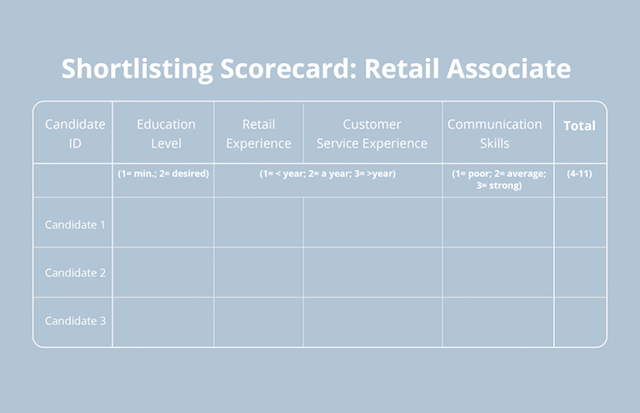
When creating a scorecard for your business, make it a collaborative process, especially if there’s more than one hiring manager.
Whether you’re hosting in-person interviews or setting up a video conference to meet with remote candidates, everyone on your team can be equipped with a scorecard before the interview begins.
Information technology (IT)
7. Use a (modern) phone system
These days, having a good business phone system is mandatory for running almost any business. Beyond being able to manage outbound and inbound calls, your phone system should include features like:
- Tracking call histories, usages, and service quality
- Supporting conference calls with participants in remote locations
- Being able to instantly switch live calls between desktop and mobiles apps:
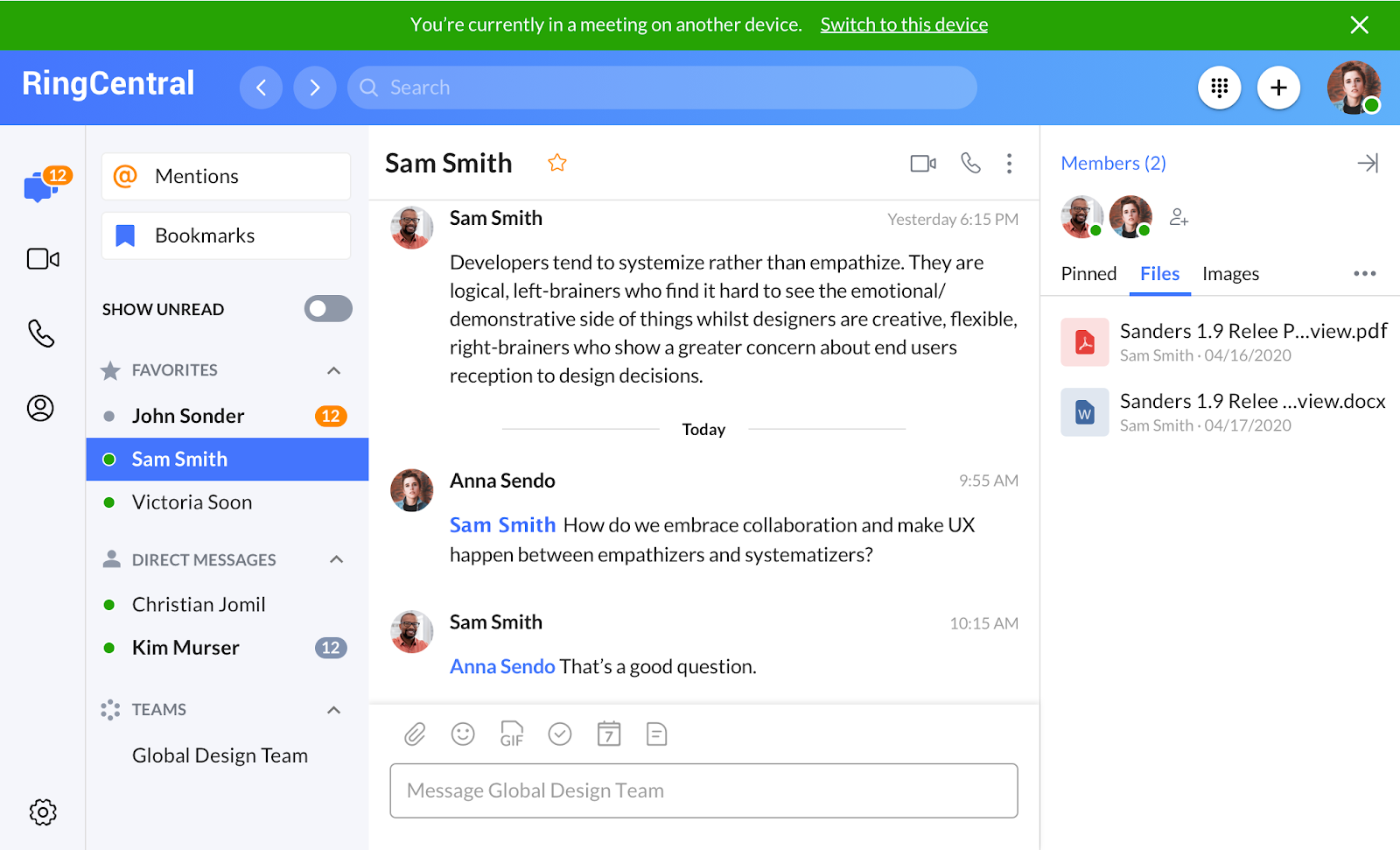
Caption: For example, RingCentral’s desktop and mobile apps let you switch between devices while you’re in a meeting (so that if you’re taking a call on your phone, you can switch it to your computer once you get to your desk).
There are two major types of phone systems to be aware of:
- Private branch exchange system (PBX system): This traditional model makes use of a network of physical phone lines, handsets, and supporting equipment.
- Voice over internet protocol (VoIP): This innovative model is the latest in business communications technology and uses an internet connection to make calls.
In recent years, more and more small to medium-sized businesses are switching to VoIP systems. In fact, these businesses are projected to grow by 15% in the VoIP market by 2025!
The reason for this is simple: huge cost savings.
For example, by switching to a modern VoIP phone system (like RingCentral), businesses are saving between 30% and 50% on average by getting rid of physical phone systems and allowing employees to bring their own devices (BYOD) to work.
Even if employees aren’t interested in using their own phones, some phone systems include features like video conferencing and team messaging—all in one platform. Here’s an example of how it works:
8. Set up a secure cloud-storage solution
En route to deliver a sales pitch and don’t have the files from your computer to reference at the last minute? Or doing a remote sales demo and need to show a document that only your coworker has?
These days, you need to be able to access data on the go and across teams. Not just because you might be on your phone instead of your computer or whatever device those files were saved on, but from a collaboration standpoint as well.
Having a cloud-storage solution like Google Drive, Box, or OneDrive means you can share and access your files securely.
Need to send a document to a coworker for feedback? You can do that quickly from any desktop or mobile.
Plus, most cloud-storage solutions (such as the three listed above) have built-in collaboration features and even integrate with communication tools. That means you could get notified whenever a file gets uploaded and share files right in your team messaging app:
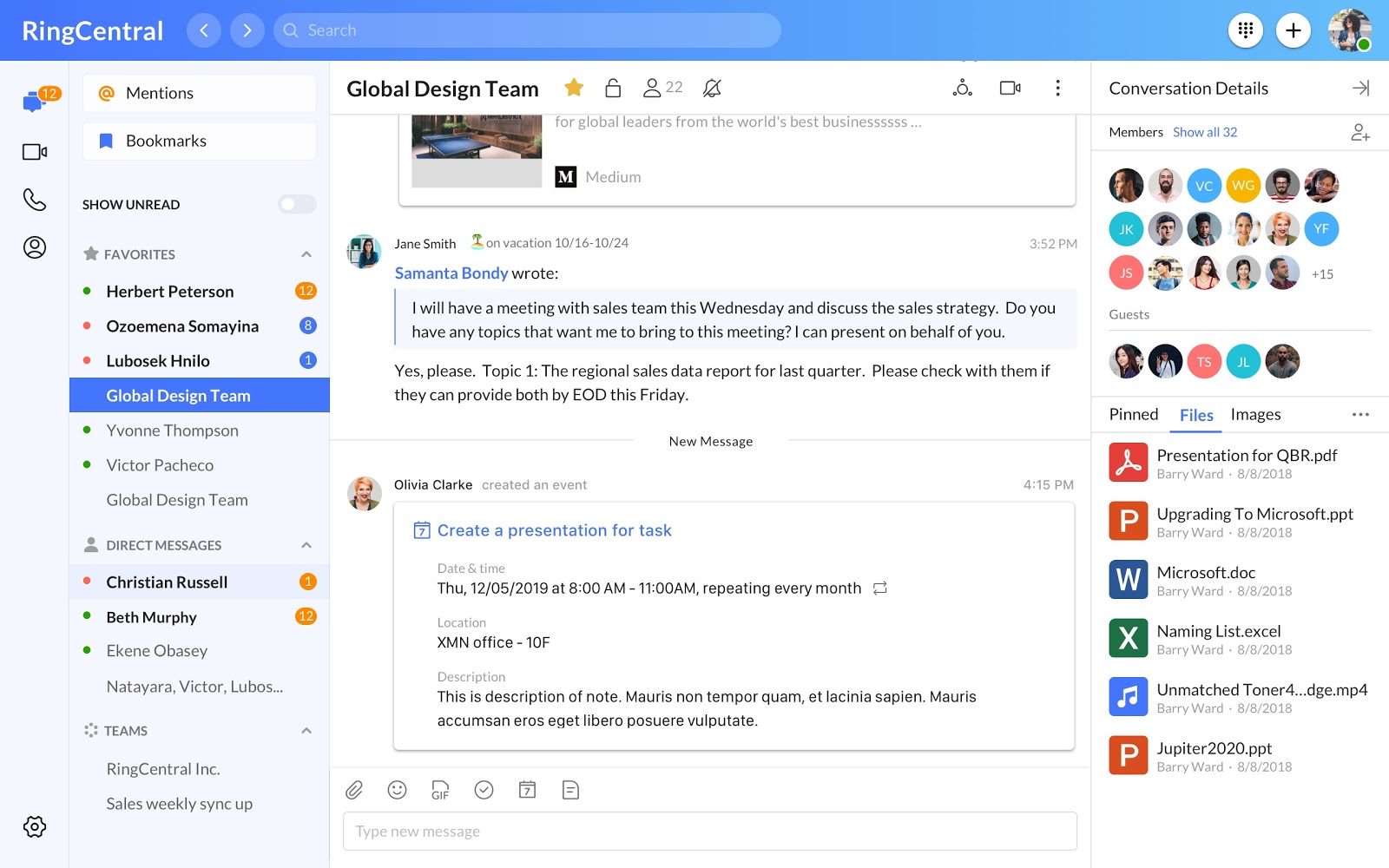
Caption: Instead of losing files in endless email threads, how about sharing and pinning them in a team chat in RingCentral’s desktop app?
When you’re just starting out, it can be tempting to use what you already know. This usually looks like using the Microsoft Office suite to create and save files to your local drive. But it’s not always the most efficient way to do it.
Pro-tip: Don’t forget about scalability. As you grow, you’ll need to find a way to manage growing amounts of data so consider making the switch to a more effective cloud-tool sooner rather than later.
How to apply these best practices to your business today
These best practices are straightforward, but do take a bit of commitment and focus to get up and running. So, before you tackle any one of them, choose your priorities!
If you’re looking to save on costs and consolidate the number of tools you’re using (and subscription fees you’re paying), then RingCentral’s all-in-one communication platform is a good way to get started.
If you find that you’re not attracting the right customers, then maybe you need to go back to the drawing board and focus on redefining your brand values.
Remember, although best practices are seen as proven methods for success, you have to adapt them to your business to truly get the most out of them.



